Contract Law Assignment: Exclusion Clauses, Terms, and Case Studies
VerifiedAdded on 2020/04/13
|7
|1671
|304
Homework Assignment
AI Summary
This assignment delves into key aspects of contract law, specifically focusing on contractual terms and exclusion clauses. It begins by defining and differentiating between conditions, warranties, and innominate terms, supported by landmark cases like Poussard v Spiers and Bettini v Gye. The assignment then explores the concept of exclusion clauses, which limit or restrict liability, and discusses their validity based on proper incorporation into the contract. Cases such as Thornton v Shoe Lane Parking Ltd. and Olley v Marlborough Court are analyzed to illustrate the importance of bringing exclusion clauses to the attention of the parties involved. The assignment then applies these legal principles to a case study involving injuries at a concert, assessing the validity of an exclusion clause printed on the back of a ticket. Ultimately, the assignment concludes that, based on the analysis, the exclusion clause would likely be upheld, thus denying the claims of the injured parties.

qwertyuiopasdfghjklzxcvbnmqwertyui
opasdfghjklzxcvbnmqwertyuiopasdfgh
jklzxcvbnmqwertyuiopasdfghjklzxcvb
nmqwertyuiopasdfghjklzxcvbnmqwer
tyuiopasdfghjklzxcvbnmqwertyuiopas
dfghjklzxcvbnmqwertyuiopasdfghjklzx
cvbnmqwertyuiopasdfghjklzxcvbnmq
wertyuiopasdfghjklzxcvbnmqwertyuio
pasdfghjklzxcvbnmqwertyuiopasdfghj
Business Law
Individual Assignment
18-Nov-17
(Student Details: )
opasdfghjklzxcvbnmqwertyuiopasdfgh
jklzxcvbnmqwertyuiopasdfghjklzxcvb
nmqwertyuiopasdfghjklzxcvbnmqwer
tyuiopasdfghjklzxcvbnmqwertyuiopas
dfghjklzxcvbnmqwertyuiopasdfghjklzx
cvbnmqwertyuiopasdfghjklzxcvbnmq
wertyuiopasdfghjklzxcvbnmqwertyuio
pasdfghjklzxcvbnmqwertyuiopasdfghj
Business Law
Individual Assignment
18-Nov-17
(Student Details: )
Paraphrase This Document
Need a fresh take? Get an instant paraphrase of this document with our AI Paraphraser
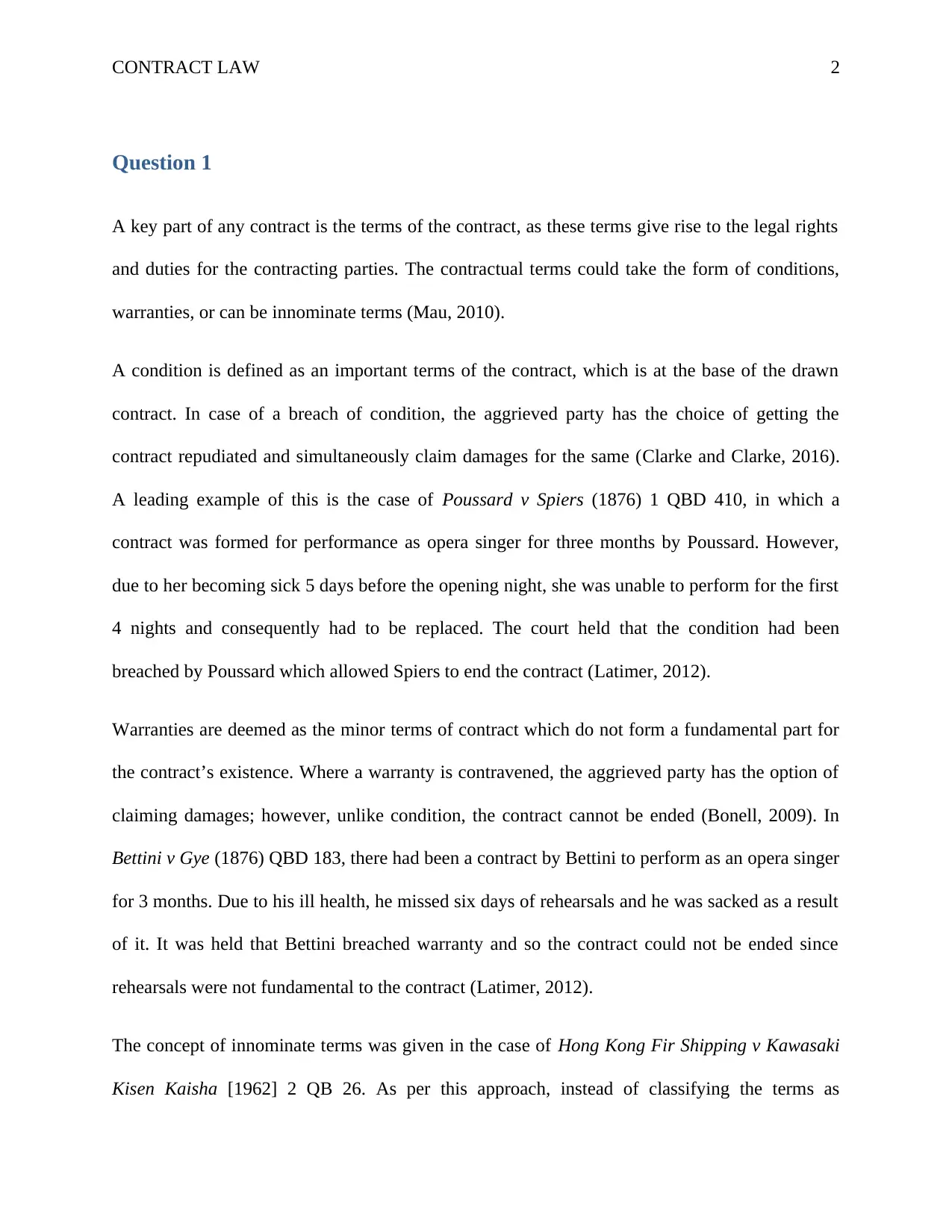
CONTRACT LAW 2
Question 1
A key part of any contract is the terms of the contract, as these terms give rise to the legal rights
and duties for the contracting parties. The contractual terms could take the form of conditions,
warranties, or can be innominate terms (Mau, 2010).
A condition is defined as an important terms of the contract, which is at the base of the drawn
contract. In case of a breach of condition, the aggrieved party has the choice of getting the
contract repudiated and simultaneously claim damages for the same (Clarke and Clarke, 2016).
A leading example of this is the case of Poussard v Spiers (1876) 1 QBD 410, in which a
contract was formed for performance as opera singer for three months by Poussard. However,
due to her becoming sick 5 days before the opening night, she was unable to perform for the first
4 nights and consequently had to be replaced. The court held that the condition had been
breached by Poussard which allowed Spiers to end the contract (Latimer, 2012).
Warranties are deemed as the minor terms of contract which do not form a fundamental part for
the contract’s existence. Where a warranty is contravened, the aggrieved party has the option of
claiming damages; however, unlike condition, the contract cannot be ended (Bonell, 2009). In
Bettini v Gye (1876) QBD 183, there had been a contract by Bettini to perform as an opera singer
for 3 months. Due to his ill health, he missed six days of rehearsals and he was sacked as a result
of it. It was held that Bettini breached warranty and so the contract could not be ended since
rehearsals were not fundamental to the contract (Latimer, 2012).
The concept of innominate terms was given in the case of Hong Kong Fir Shipping v Kawasaki
Kisen Kaisha [1962] 2 QB 26. As per this approach, instead of classifying the terms as
Question 1
A key part of any contract is the terms of the contract, as these terms give rise to the legal rights
and duties for the contracting parties. The contractual terms could take the form of conditions,
warranties, or can be innominate terms (Mau, 2010).
A condition is defined as an important terms of the contract, which is at the base of the drawn
contract. In case of a breach of condition, the aggrieved party has the choice of getting the
contract repudiated and simultaneously claim damages for the same (Clarke and Clarke, 2016).
A leading example of this is the case of Poussard v Spiers (1876) 1 QBD 410, in which a
contract was formed for performance as opera singer for three months by Poussard. However,
due to her becoming sick 5 days before the opening night, she was unable to perform for the first
4 nights and consequently had to be replaced. The court held that the condition had been
breached by Poussard which allowed Spiers to end the contract (Latimer, 2012).
Warranties are deemed as the minor terms of contract which do not form a fundamental part for
the contract’s existence. Where a warranty is contravened, the aggrieved party has the option of
claiming damages; however, unlike condition, the contract cannot be ended (Bonell, 2009). In
Bettini v Gye (1876) QBD 183, there had been a contract by Bettini to perform as an opera singer
for 3 months. Due to his ill health, he missed six days of rehearsals and he was sacked as a result
of it. It was held that Bettini breached warranty and so the contract could not be ended since
rehearsals were not fundamental to the contract (Latimer, 2012).
The concept of innominate terms was given in the case of Hong Kong Fir Shipping v Kawasaki
Kisen Kaisha [1962] 2 QB 26. As per this approach, instead of classifying the terms as
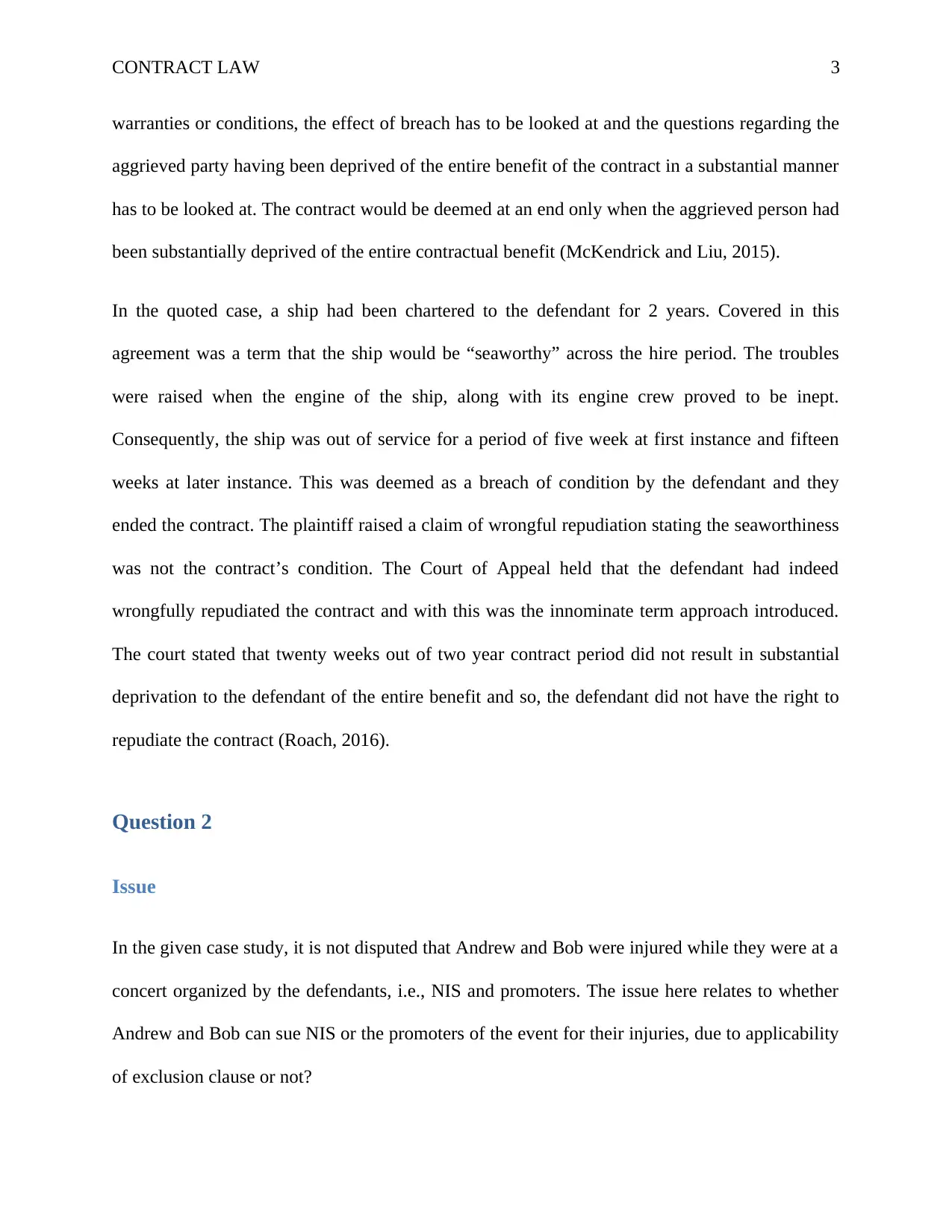
CONTRACT LAW 3
warranties or conditions, the effect of breach has to be looked at and the questions regarding the
aggrieved party having been deprived of the entire benefit of the contract in a substantial manner
has to be looked at. The contract would be deemed at an end only when the aggrieved person had
been substantially deprived of the entire contractual benefit (McKendrick and Liu, 2015).
In the quoted case, a ship had been chartered to the defendant for 2 years. Covered in this
agreement was a term that the ship would be “seaworthy” across the hire period. The troubles
were raised when the engine of the ship, along with its engine crew proved to be inept.
Consequently, the ship was out of service for a period of five week at first instance and fifteen
weeks at later instance. This was deemed as a breach of condition by the defendant and they
ended the contract. The plaintiff raised a claim of wrongful repudiation stating the seaworthiness
was not the contract’s condition. The Court of Appeal held that the defendant had indeed
wrongfully repudiated the contract and with this was the innominate term approach introduced.
The court stated that twenty weeks out of two year contract period did not result in substantial
deprivation to the defendant of the entire benefit and so, the defendant did not have the right to
repudiate the contract (Roach, 2016).
Question 2
Issue
In the given case study, it is not disputed that Andrew and Bob were injured while they were at a
concert organized by the defendants, i.e., NIS and promoters. The issue here relates to whether
Andrew and Bob can sue NIS or the promoters of the event for their injuries, due to applicability
of exclusion clause or not?
warranties or conditions, the effect of breach has to be looked at and the questions regarding the
aggrieved party having been deprived of the entire benefit of the contract in a substantial manner
has to be looked at. The contract would be deemed at an end only when the aggrieved person had
been substantially deprived of the entire contractual benefit (McKendrick and Liu, 2015).
In the quoted case, a ship had been chartered to the defendant for 2 years. Covered in this
agreement was a term that the ship would be “seaworthy” across the hire period. The troubles
were raised when the engine of the ship, along with its engine crew proved to be inept.
Consequently, the ship was out of service for a period of five week at first instance and fifteen
weeks at later instance. This was deemed as a breach of condition by the defendant and they
ended the contract. The plaintiff raised a claim of wrongful repudiation stating the seaworthiness
was not the contract’s condition. The Court of Appeal held that the defendant had indeed
wrongfully repudiated the contract and with this was the innominate term approach introduced.
The court stated that twenty weeks out of two year contract period did not result in substantial
deprivation to the defendant of the entire benefit and so, the defendant did not have the right to
repudiate the contract (Roach, 2016).
Question 2
Issue
In the given case study, it is not disputed that Andrew and Bob were injured while they were at a
concert organized by the defendants, i.e., NIS and promoters. The issue here relates to whether
Andrew and Bob can sue NIS or the promoters of the event for their injuries, due to applicability
of exclusion clause or not?
⊘ This is a preview!⊘
Do you want full access?
Subscribe today to unlock all pages.

Trusted by 1+ million students worldwide
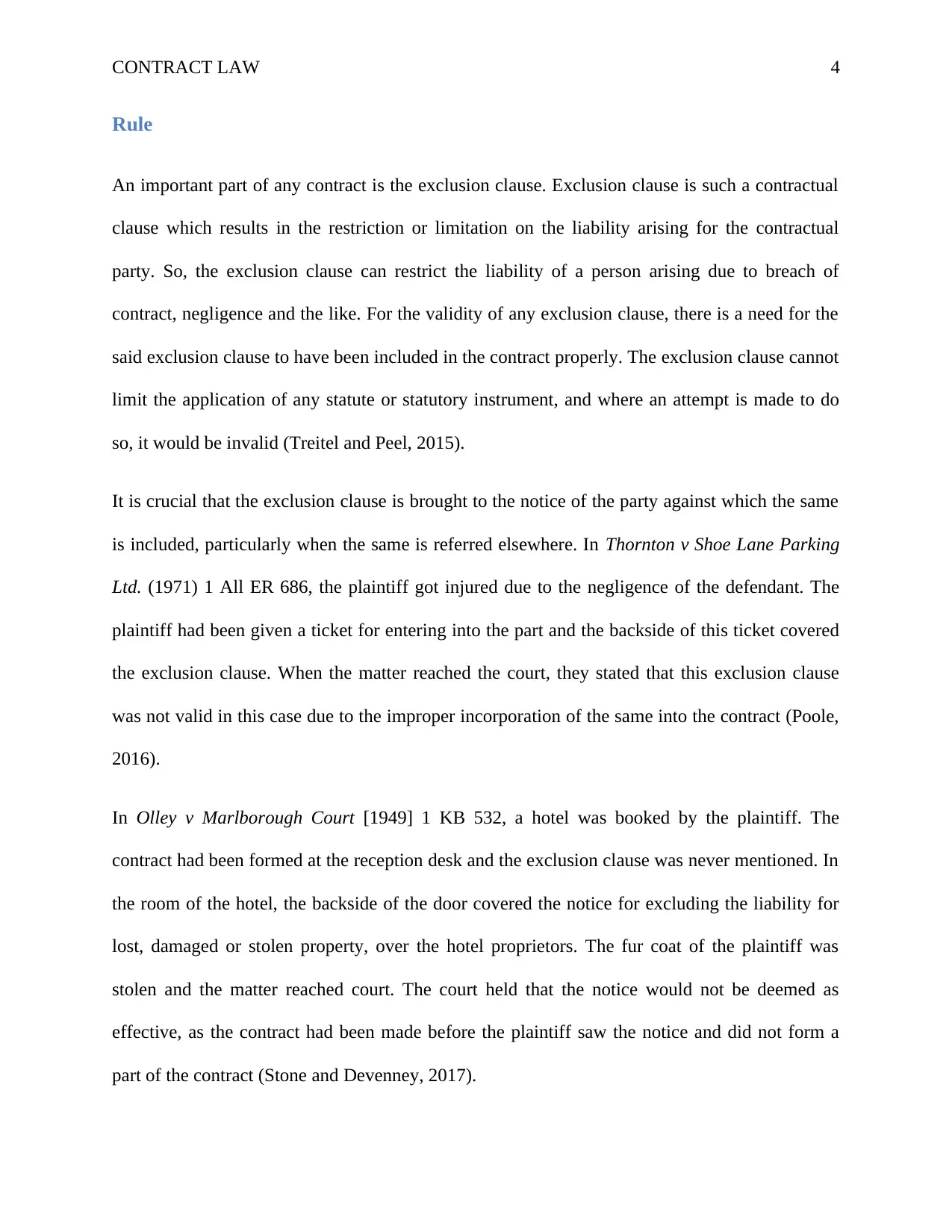
CONTRACT LAW 4
Rule
An important part of any contract is the exclusion clause. Exclusion clause is such a contractual
clause which results in the restriction or limitation on the liability arising for the contractual
party. So, the exclusion clause can restrict the liability of a person arising due to breach of
contract, negligence and the like. For the validity of any exclusion clause, there is a need for the
said exclusion clause to have been included in the contract properly. The exclusion clause cannot
limit the application of any statute or statutory instrument, and where an attempt is made to do
so, it would be invalid (Treitel and Peel, 2015).
It is crucial that the exclusion clause is brought to the notice of the party against which the same
is included, particularly when the same is referred elsewhere. In Thornton v Shoe Lane Parking
Ltd. (1971) 1 All ER 686, the plaintiff got injured due to the negligence of the defendant. The
plaintiff had been given a ticket for entering into the part and the backside of this ticket covered
the exclusion clause. When the matter reached the court, they stated that this exclusion clause
was not valid in this case due to the improper incorporation of the same into the contract (Poole,
2016).
In Olley v Marlborough Court [1949] 1 KB 532, a hotel was booked by the plaintiff. The
contract had been formed at the reception desk and the exclusion clause was never mentioned. In
the room of the hotel, the backside of the door covered the notice for excluding the liability for
lost, damaged or stolen property, over the hotel proprietors. The fur coat of the plaintiff was
stolen and the matter reached court. The court held that the notice would not be deemed as
effective, as the contract had been made before the plaintiff saw the notice and did not form a
part of the contract (Stone and Devenney, 2017).
Rule
An important part of any contract is the exclusion clause. Exclusion clause is such a contractual
clause which results in the restriction or limitation on the liability arising for the contractual
party. So, the exclusion clause can restrict the liability of a person arising due to breach of
contract, negligence and the like. For the validity of any exclusion clause, there is a need for the
said exclusion clause to have been included in the contract properly. The exclusion clause cannot
limit the application of any statute or statutory instrument, and where an attempt is made to do
so, it would be invalid (Treitel and Peel, 2015).
It is crucial that the exclusion clause is brought to the notice of the party against which the same
is included, particularly when the same is referred elsewhere. In Thornton v Shoe Lane Parking
Ltd. (1971) 1 All ER 686, the plaintiff got injured due to the negligence of the defendant. The
plaintiff had been given a ticket for entering into the part and the backside of this ticket covered
the exclusion clause. When the matter reached the court, they stated that this exclusion clause
was not valid in this case due to the improper incorporation of the same into the contract (Poole,
2016).
In Olley v Marlborough Court [1949] 1 KB 532, a hotel was booked by the plaintiff. The
contract had been formed at the reception desk and the exclusion clause was never mentioned. In
the room of the hotel, the backside of the door covered the notice for excluding the liability for
lost, damaged or stolen property, over the hotel proprietors. The fur coat of the plaintiff was
stolen and the matter reached court. The court held that the notice would not be deemed as
effective, as the contract had been made before the plaintiff saw the notice and did not form a
part of the contract (Stone and Devenney, 2017).
Paraphrase This Document
Need a fresh take? Get an instant paraphrase of this document with our AI Paraphraser
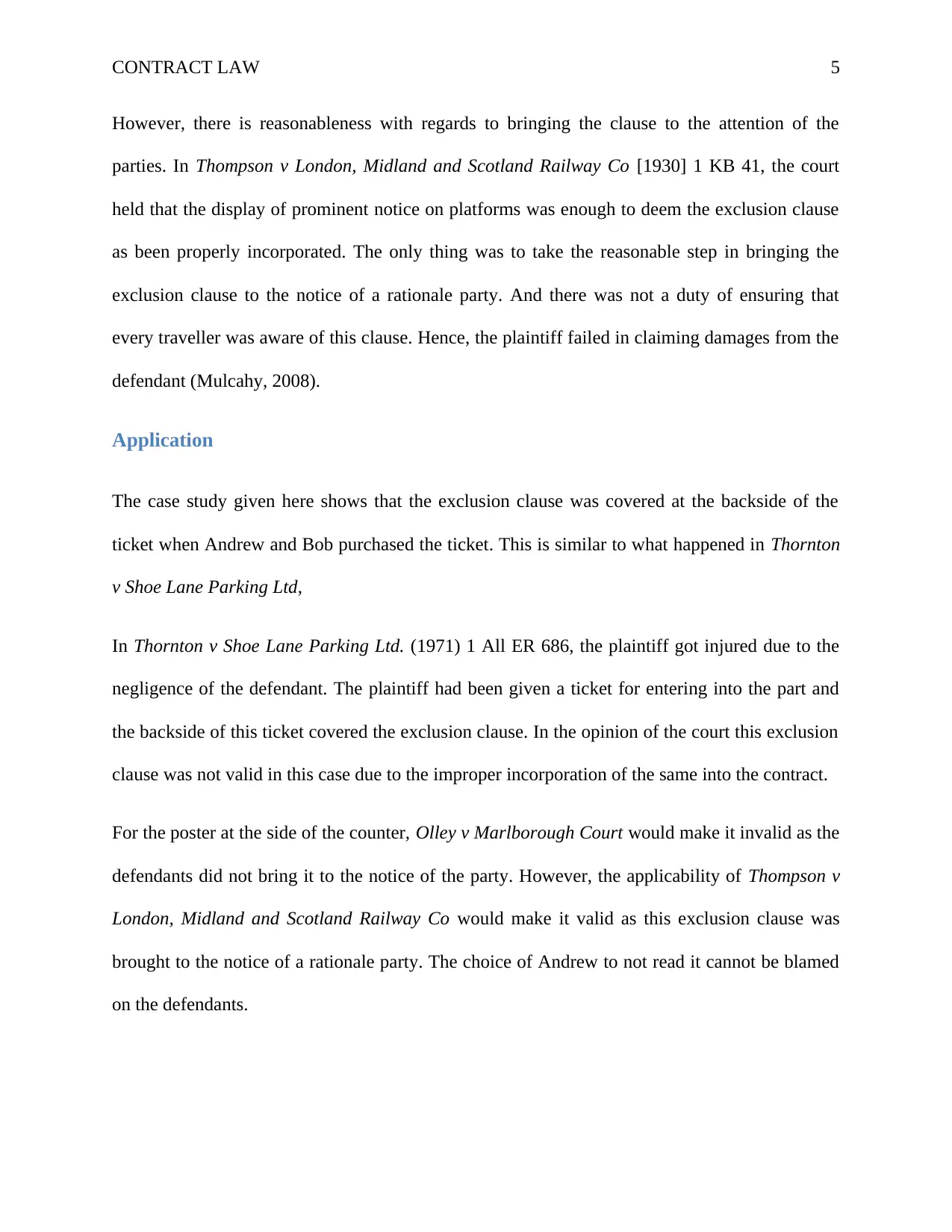
CONTRACT LAW 5
However, there is reasonableness with regards to bringing the clause to the attention of the
parties. In Thompson v London, Midland and Scotland Railway Co [1930] 1 KB 41, the court
held that the display of prominent notice on platforms was enough to deem the exclusion clause
as been properly incorporated. The only thing was to take the reasonable step in bringing the
exclusion clause to the notice of a rationale party. And there was not a duty of ensuring that
every traveller was aware of this clause. Hence, the plaintiff failed in claiming damages from the
defendant (Mulcahy, 2008).
Application
The case study given here shows that the exclusion clause was covered at the backside of the
ticket when Andrew and Bob purchased the ticket. This is similar to what happened in Thornton
v Shoe Lane Parking Ltd,
In Thornton v Shoe Lane Parking Ltd. (1971) 1 All ER 686, the plaintiff got injured due to the
negligence of the defendant. The plaintiff had been given a ticket for entering into the part and
the backside of this ticket covered the exclusion clause. In the opinion of the court this exclusion
clause was not valid in this case due to the improper incorporation of the same into the contract.
For the poster at the side of the counter, Olley v Marlborough Court would make it invalid as the
defendants did not bring it to the notice of the party. However, the applicability of Thompson v
London, Midland and Scotland Railway Co would make it valid as this exclusion clause was
brought to the notice of a rationale party. The choice of Andrew to not read it cannot be blamed
on the defendants.
However, there is reasonableness with regards to bringing the clause to the attention of the
parties. In Thompson v London, Midland and Scotland Railway Co [1930] 1 KB 41, the court
held that the display of prominent notice on platforms was enough to deem the exclusion clause
as been properly incorporated. The only thing was to take the reasonable step in bringing the
exclusion clause to the notice of a rationale party. And there was not a duty of ensuring that
every traveller was aware of this clause. Hence, the plaintiff failed in claiming damages from the
defendant (Mulcahy, 2008).
Application
The case study given here shows that the exclusion clause was covered at the backside of the
ticket when Andrew and Bob purchased the ticket. This is similar to what happened in Thornton
v Shoe Lane Parking Ltd,
In Thornton v Shoe Lane Parking Ltd. (1971) 1 All ER 686, the plaintiff got injured due to the
negligence of the defendant. The plaintiff had been given a ticket for entering into the part and
the backside of this ticket covered the exclusion clause. In the opinion of the court this exclusion
clause was not valid in this case due to the improper incorporation of the same into the contract.
For the poster at the side of the counter, Olley v Marlborough Court would make it invalid as the
defendants did not bring it to the notice of the party. However, the applicability of Thompson v
London, Midland and Scotland Railway Co would make it valid as this exclusion clause was
brought to the notice of a rationale party. The choice of Andrew to not read it cannot be blamed
on the defendants.
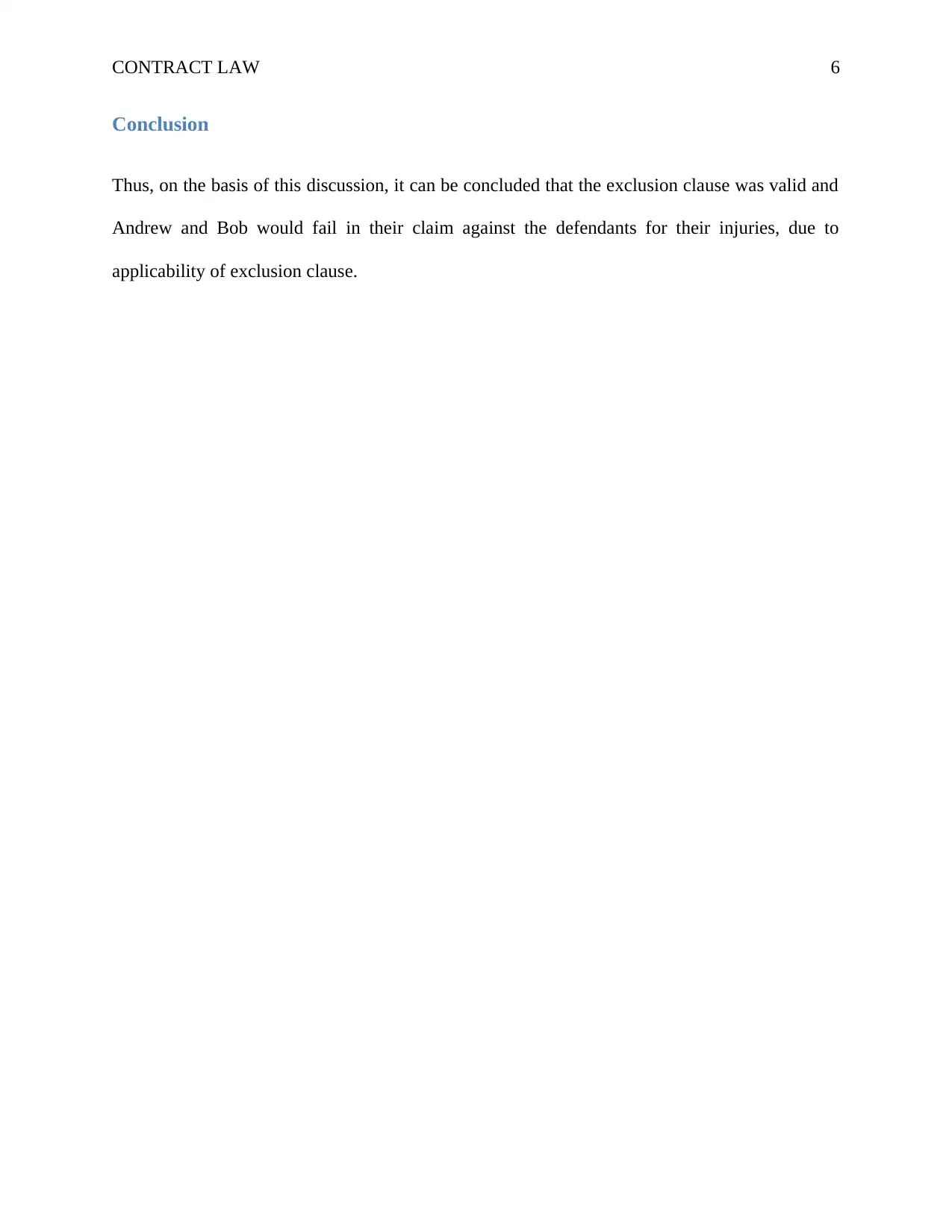
CONTRACT LAW 6
Conclusion
Thus, on the basis of this discussion, it can be concluded that the exclusion clause was valid and
Andrew and Bob would fail in their claim against the defendants for their injuries, due to
applicability of exclusion clause.
Conclusion
Thus, on the basis of this discussion, it can be concluded that the exclusion clause was valid and
Andrew and Bob would fail in their claim against the defendants for their injuries, due to
applicability of exclusion clause.
⊘ This is a preview!⊘
Do you want full access?
Subscribe today to unlock all pages.

Trusted by 1+ million students worldwide

CONTRACT LAW 7
References
Bonell, M.J. (2009) An International Restatement of Contract Law: The Unidroit Principles of
International Commercial Contracts. 3rd ed. New York: Transnational Publishers, Inc.
Clarke, P., and Clarke, J (2016) Contract Law: Commentaries, Cases and Perspectives. 3rd ed.
South Melbourne: Oxford University Press.
Latimer, P. (2012) Australian Business Law 2012. 31st ed. Sydney, NSW: CCH Australia
Limited.
Mau, S.D. (2010) Contract Law in Hong Kong: An Introductory Guide. Hong Kong: Hong Kong
University Press.
McKendrick, E., and Liu, Q. (2015) Contract Law: Australian Edition. London: Palgrave.
Mulcahy, L. (2008) Contract Law in Perspective. 5th ed. Oxon: Routledge.
Poole, J. (2016) Textbook on Contract Law. 13th ed. Oxford: Oxford University Press.
Roach, L. (2016) Card and James' Business Law. 4th ed. Oxford: Oxford University Press.
Stone, R., and Devenney, J. (2017) The Modern Law of Contract. 12th ed. Oxon: Routledge.
Treitel, G H., and Peel, E. (2015) The Law of Contract. 14th ed. London: Sweet and Maxwell.
References
Bonell, M.J. (2009) An International Restatement of Contract Law: The Unidroit Principles of
International Commercial Contracts. 3rd ed. New York: Transnational Publishers, Inc.
Clarke, P., and Clarke, J (2016) Contract Law: Commentaries, Cases and Perspectives. 3rd ed.
South Melbourne: Oxford University Press.
Latimer, P. (2012) Australian Business Law 2012. 31st ed. Sydney, NSW: CCH Australia
Limited.
Mau, S.D. (2010) Contract Law in Hong Kong: An Introductory Guide. Hong Kong: Hong Kong
University Press.
McKendrick, E., and Liu, Q. (2015) Contract Law: Australian Edition. London: Palgrave.
Mulcahy, L. (2008) Contract Law in Perspective. 5th ed. Oxon: Routledge.
Poole, J. (2016) Textbook on Contract Law. 13th ed. Oxford: Oxford University Press.
Roach, L. (2016) Card and James' Business Law. 4th ed. Oxford: Oxford University Press.
Stone, R., and Devenney, J. (2017) The Modern Law of Contract. 12th ed. Oxon: Routledge.
Treitel, G H., and Peel, E. (2015) The Law of Contract. 14th ed. London: Sweet and Maxwell.
1 out of 7
Related Documents
Your All-in-One AI-Powered Toolkit for Academic Success.
+13062052269
info@desklib.com
Available 24*7 on WhatsApp / Email
![[object Object]](/_next/static/media/star-bottom.7253800d.svg)
Unlock your academic potential
Copyright © 2020–2025 A2Z Services. All Rights Reserved. Developed and managed by ZUCOL.





